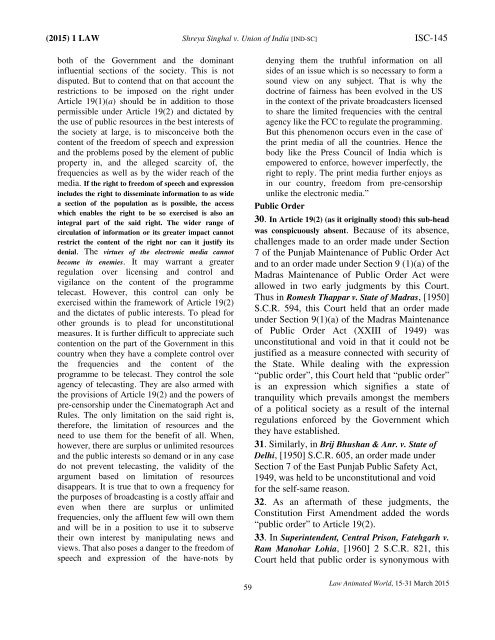Editor: I. Mallikarjuna Sharma Volume 11: 15-31 March 2015 No. 5-6
Martyrs memorial special issue of 15-31 March 2015 paying tributes to Bhagat Singh and other comrades.
Martyrs memorial special issue of 15-31 March 2015 paying tributes to Bhagat Singh and other comrades.
You also want an ePaper? Increase the reach of your titles
YUMPU automatically turns print PDFs into web optimized ePapers that Google loves.
(20<strong>15</strong>) 1 LAW Shreya Singhal v. Union of India [IND-SC] ISC-145<br />
both of the Government and the dominant<br />
influential sections of the society. This is not<br />
disputed. But to contend that on that account the<br />
restrictions to be imposed on the right under<br />
Article 19(1)(a) should be in addition to those<br />
permissible under Article 19(2) and dictated by<br />
the use of public resources in the best interests of<br />
the society at large, is to misconceive both the<br />
content of the freedom of speech and expression<br />
and the problems posed by the element of public<br />
property in, and the alleged scarcity of, the<br />
frequencies as well as by the wider reach of the<br />
media. If the right to freedom of speech and expression<br />
includes the right to disseminate information to as wide<br />
a section of the population as is possible, the access<br />
which enables the right to be so exercised is also an<br />
integral part of the said right. The wider range of<br />
circulation of information or its greater impact cannot<br />
restrict the content of the right nor can it justify its<br />
denial. The virtues of the electronic media cannot<br />
become its enemies. It may warrant a greater<br />
regulation over licensing and control and<br />
vigilance on the content of the programme<br />
telecast. However, this control can only be<br />
exercised within the framework of Article 19(2)<br />
and the dictates of public interests. To plead for<br />
other grounds is to plead for unconstitutional<br />
measures. It is further difficult to appreciate such<br />
contention on the part of the Government in this<br />
country when they have a complete control over<br />
the frequencies and the content of the<br />
programme to be telecast. They control the sole<br />
agency of telecasting. They are also armed with<br />
the provisions of Article 19(2) and the powers of<br />
pre-censorship under the Cinematograph Act and<br />
Rules. The only limitation on the said right is,<br />
therefore, the limitation of resources and the<br />
need to use them for the benefit of all. When,<br />
however, there are surplus or unlimited resources<br />
and the public interests so demand or in any case<br />
do not prevent telecasting, the validity of the<br />
argument based on limitation of resources<br />
disappears. It is true that to own a frequency for<br />
the purposes of broadcasting is a costly affair and<br />
even when there are surplus or unlimited<br />
frequencies, only the affluent few will own them<br />
and will be in a position to use it to subserve<br />
their own interest by manipulating news and<br />
views. That also poses a danger to the freedom of<br />
speech and expression of the have-nots by<br />
denying them the truthful information on all<br />
sides of an issue which is so necessary to form a<br />
sound view on any subject. That is why the<br />
doctrine of fairness has been evolved in the US<br />
in the context of the private broadcasters licensed<br />
to share the limited frequencies with the central<br />
agency like the FCC to regulate the programming.<br />
But this phenomenon occurs even in the case of<br />
the print media of all the countries. Hence the<br />
body like the Press Council of India which is<br />
empowered to enforce, however imperfectly, the<br />
right to reply. The print media further enjoys as<br />
in our country, freedom from pre-censorship<br />
unlike the electronic media.”<br />
Public Order<br />
30. In Article 19(2) (as it originally stood) this sub-head<br />
was conspicuously absent. Because of its absence,<br />
challenges made to an order made under Section<br />
7 of the Punjab Maintenance of Public Order Act<br />
and to an order made under Section 9 (1)(a) of the<br />
Madras Maintenance of Public Order Act were<br />
allowed in two early judgments by this Court.<br />
Thus in Romesh Thappar v. State of Madras, [1950]<br />
S.C.R. 594, this Court held that an order made<br />
under Section 9(1)(a) of the Madras Maintenance<br />
of Public Order Act (XXIII of 1949) was<br />
unconstitutional and void in that it could not be<br />
justified as a measure connected with security of<br />
the State. While dealing with the expression<br />
“public order”, this Court held that “public order”<br />
is an expression which signifies a state of<br />
tranquility which prevails amongst the members<br />
of a political society as a result of the internal<br />
regulations enforced by the Government which<br />
they have established.<br />
<strong>31</strong>. Similarly, in Brij Bhushan & Anr. v. State of<br />
Delhi, [1950] S.C.R. 605, an order made under<br />
Section 7 of the East Punjab Public Safety Act,<br />
1949, was held to be unconstitutional and void<br />
for the self-same reason.<br />
32. As an aftermath of these judgments, the<br />
Constitution First Amendment added the words<br />
“public order” to Article 19(2).<br />
33. In Superintendent, Central Prison, Fatehgarh v.<br />
Ram Manohar Lohia, [1960] 2 S.C.R. 821, this<br />
Court held that public order is synonymous with<br />
59<br />
Law Animated World, <strong>15</strong>-<strong>31</strong> <strong>March</strong> 20<strong>15</strong>



